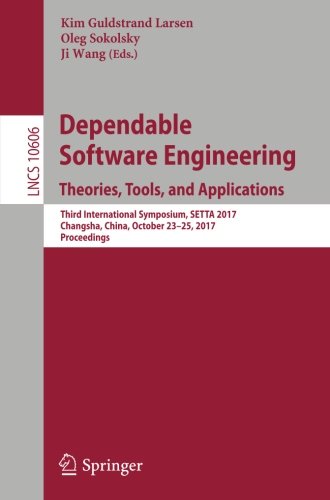
Dependable Software Engineering: Theories, Tools, and Applications
- Length: 351 pages
- Edition: 1st ed. 2017
- Language: English
- Publisher: Springer
- Publication Date: 2017-11-21
- ISBN-10: 3319694820
- ISBN-13: 9783319694825
Dependable Software Engineering. Theories, Tools, and Applications: Third International Symposium, SETTA 2017, Changsha, China, October 23-25, 2017, Proceedings (Lecture Notes in Computer Science)
This book constitutes the proceedings of the Third International Symposium on Dependable Software Engineering: Theories, Tools, and Applications, SETTA 2017, held in Changsha, China, in October 2017.
The 19 full papers presented together with 3 invited talks were carefully reviewed and selected from 31 submissions. The aim of the symposium is to bring together international researchers and practitioners in the field of software technology. Its focus is on probabilistic and statistical analysis; timed and hybrid systems; program analysis; modeling and verification; formalization; and tools.
Table of Contents
Chapter 1. General Lessons from a Rely/Guarantee Development
Chapter 2. Polynomial-Time Alternating Probabilistic Bisimulation for Interval MDPs
Chapter 3. Better Automated Importance Splitting for Transient Rare Events
Chapter 4. On the Criticality of Probabilistic Worst-Case Execution Time Models
Chapter 5. Nested Timed Automata with Invariants
Chapter 6. Multi-core Cyclic Executives for Safety-Critical Systems
Chapter 7. Compositional Hoare-Style Reasoning About Hybrid CSP in the Duration Calculus
Chapter 8. Termination of Semi-algebraic Loop Programs
Chapter 9. Computing Exact Loop Bounds for Bounded Program Verification
Chapter 10. AndroidLeaker: A Hybrid Checker for Collusive Leak in Android Applications
Chapter 11. Remark on Some Variants
Chapter 12. Reasoning About Periodicity on Infinite Words
Chapter 13. On Equivalence Checking of Nondeterministic Finite Automata
Chapter 14. A New Decomposition Method for Attractor Detection in Large Synchronous Boolean Networks
Chapter 15. Construction of Abstract State Graphs for Understanding Event-B Models
Chapter 16. A Framework for Modeling and Verifying IoT Communication Protocols
Chapter 17. Formal Analysis of Information Flow in HOL
Chapter 18. Formalizing SPARCv8 Instruction Set Architecture in Coq
Chapter 19. How to Efficiently Build a Front-End Tool for UPPAAL: A Model-Driven Approach
Chapter 20. PranCS: A Protocol and Discrete Controller Synthesis Tool







